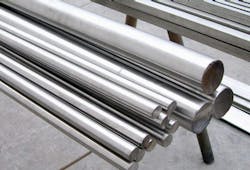Comparing Different Carbon Steel Grades
Carbon steel consists of numerous different grades that offer different properties, and machinists and fabricators must select specific carbon-steel grades for particular projects, as the finished product application may indicate. Each type of steel has different advantages over others. However, the main difference between these steel grades is the amount of carbon mixed with iron during the refining process. Beyond that, there are many additives introduced during refining to change the properties such as tensile strength, toughness, resistance to temperature and ductility. Generally, there are three distinctions made between carbon steel types — low-carbon steel, medium-carbon steel and high-carbon steel.
Low-carbon steel — The normal range of the carbon content in low-carbon steel is between 0.03 to 0.08%. There are many applications in which low-carbon steel is used, such as the making of kitchen utensils, silverware, and un-plated sheet products. It has excellent weldability and formability.
Low-carbon grades have low tensile strength and are comparatively inexpensive. These are widely used in forming processes that call for bending, crimping, and swaging; they have high surface hardness, and making low-carbon steel preferable for making liners, machinery parts, special bolts, ratchets, chain pins, oil tool slips, tie rods, anchor pins, and studs.
Medium-carbon steel — For medium-carbon steel grades the carbon content ranges from 0.25% to 0.60%. The carbon in these products generally is introduced together with alloys of high-hardness elements like molybdenum, chromium, or nickel. Medium-carbon steels have high strength and wear-resistance.
These alloys are used in making tools and devices that require material toughness. You will find medium-carbon steel specified for components like gears, axles, studs, and other mechanical equipment where strength and hardness are required.
One widely used medium-carbon steel grade is AISI 1045, which is known for having superior machining characteristics. If a certain application requires hardness, AISI 1045 can be hardened by heat-treating to a uniform temperature of 820-850°C (1,508-1,562°F).
High-carbon steel — High-carbon steel grades are hardest and strongest among the three types of steels addressed here. Generally, the carbon content will range from 0.60% to 1.4% of the total weight. However, high-carbon steel grades are ductile, too, and with heating and tempering these materials also can be hardened. Generally, these steel grades are used to manufacture materials needed for mechanical, cutting, and bearing components.
AISI 52100 is one of the premium high-carbon steel grades that used for linear shifting parts. To add hardness and corrosion-resistance, chromium and manganese are added in the composition of 52100 steel.
Read the notations — The two institutions that designate steel alloys are the American Iron and Steel Institute (AISI) and the American Society for Testing and Materials (ASTM). Each of these bodies has a different methodology for classifying and identifying steel alloys. The AISI method gives a four-digit designation, in which, the first two digits are the alloy and the second two digits show the carbon content.
The ASTM system uses A to identify ferrous materials, followed by an assigned number. These classifications are very important to understand and follow, as they will ensure that the proper steel grade is specified and used for particular engineered products and applications. They are the common notations agreed upon by engineers, metal producers, metal distributors and buyers, and metal fabricators, for identifying and choosing the right alloy.
